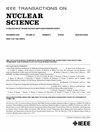微电子电路 TID 与温度效应的表征方法
IF 1.9
3区 工程技术
Q3 ENGINEERING, ELECTRICAL & ELECTRONIC
引用次数: 0
摘要
在过去的几年里,航天工业中使用的现成商用(COTS)组件数量稳步增长。然而,使用 COTS 组件需要质量控制专业人员,特别是辐射硬度保证 (RHA) 工程师付出更多努力。事实上,COTS 组件除了可追溯性较差外,还可能因辐射效应与其他环境因素(如温度)的结合而偶尔出现异常失效模式。此外,由于缺乏辐射硬化设计,这些失效模式有时难以预测和表征。本研究调查了总电离剂量 (TID) 和温度变化对 LT1521 低压差 (LDO) 稳压器的综合影响。其中特别关注了批量表征,并就 TID 与温度表征方法得出了一般性结论。研究发现,当 TID 水平高于 20 krad(Si),且温度足够低时,LT1521 有可能完全关断。最后,在电路中找出了这种故障模式的可能根源。本文章由计算机程序翻译,如有差异,请以英文原文为准。
A Characterization Method for TID Versus Temperature Effects on Microelectronic Circuits
Over the past years, the space industry has witnessed a steady increase in the amount of commercial off-the-shelf (COTS) components deployed in spacecrafts. The use of COTS components, however, requires an increased effort from quality control professionals, and specifically from radiation hardness assurance (RHA) engineers. In fact, besides being less traceable, they can also occasionally introduce unusual failure modes, caused by the association of radiation effects paired with other environmental factors, such as temperature. Moreover, the absence of Radiation Hardening By Design makes these failure modes sometimes difficult to predict and characterize. This work investigates the combined effects of total ionizing dose (TID) and temperature variations on an LT1521 low dropout (LDO) voltage regulator. Particular attention was paid to lot characterization, and general conclusions were drawn on the TID versus temperature characterization method. The LT1521 was found to be liable to a complete shutdown for TID levels higher than 20 krad(Si) and at cold enough temperatures. Finally, the likely root causes of this failure mode were identified in the circuit.
求助全文
通过发布文献求助,成功后即可免费获取论文全文。
去求助
来源期刊

IEEE Transactions on Nuclear Science
工程技术-工程:电子与电气
CiteScore
3.70
自引率
27.80%
发文量
314
审稿时长
6.2 months
期刊介绍:
The IEEE Transactions on Nuclear Science is a publication of the IEEE Nuclear and Plasma Sciences Society. It is viewed as the primary source of technical information in many of the areas it covers. As judged by JCR impact factor, TNS consistently ranks in the top five journals in the category of Nuclear Science & Technology. It has one of the higher immediacy indices, indicating that the information it publishes is viewed as timely, and has a relatively long citation half-life, indicating that the published information also is viewed as valuable for a number of years.
The IEEE Transactions on Nuclear Science is published bimonthly. Its scope includes all aspects of the theory and application of nuclear science and engineering. It focuses on instrumentation for the detection and measurement of ionizing radiation; particle accelerators and their controls; nuclear medicine and its application; effects of radiation on materials, components, and systems; reactor instrumentation and controls; and measurement of radiation in space.
 求助内容:
求助内容: 应助结果提醒方式:
应助结果提醒方式:


